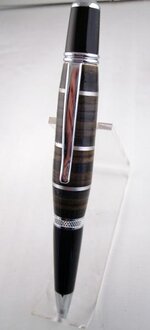I spent 39 years as a sign fabricator, using various media but mainly vinyls. I can tell you that anytime you are using a sharp edge to address a surface, a slicing action is always much more efficient and safer than a flat approach. Over the years, I had to remove many square feet of vinyls on surfaces that I didn't want to damage any more than necessary; this is why I always used a slicing action.
A skew does do a better job at "slicing." I have tried and tried learning a skew and even bought one of those high priced DVD videos as a training tool. After quite a few hours almost daily over several weeks and continuing over months of nothing but "practice", I never got consistent with it. As a result, I still do more "Shearing" than slicing, even with metal (mostly brass) segments.
Having said that, there are different times to use "Slicing" vs "Shearing", even in segments. In this link,
click here, on the 7th post down, Russ Fairfield does a good job of explaining how the different actions/tools affect the end results. Scrapers do better at shearing and give smoother results on hard woods and terrible on soft woods and softer material such as resin/plastic. Skews do better on softer woods / material over all.
I used a shear / scraper to achieve such a smooth cut that I did not need to sand - which was the intent of learning this method for segments (on hard woods) with metallic content.
In response to brass and other metals as mentioned above:
I use brass more than aluminum, but I do use aluminum. I also have used copper and lots of solder. I use these in Holly, Bloodwood, Ebonies and others of course. Holly requires that there is NO sanding dust on it. RARELY will one clean holly adequately from metallic sanding dust so that it is acceptable. The best way is to NOT get sanding dust on it in the first place. Ebonies are easier to clean, but porous and light colored woods are not.
In using the scraper (sharpened to the point the blade has a mirror finnish) I turn the lathe up to 1800 RPM or higher and do small light touches until it is sized - small bites - faster creates more heat build up and heat is the enemy as much as too fast a cut which will cause a blowout due to a "catch". I lap the chisel several times during the process. This also allows a small cool down time.
I have not done some of the heavy segments with metal as others but I do mostly straight forward segments as shown
here and
here. The first pict was the first pen that I did without ANY sanding on the wood or brass. I covered it with reveal layers of medium CA and sanded the CA down to size, but no sandpaper touched the wood/brass/solder.

